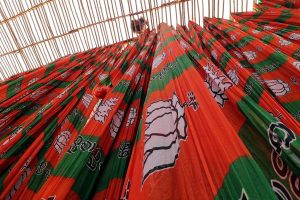The Union government on 10 August told the Supreme Court that the seven ‘killers’ cannot be released as the case involved the brutal assassination of former Prime Minister Rajiv Gandhi in pursuance of a “diabolical plot” executed by a highly organised “foreign terrorist organisation.”
The decision presented before a three-judge Bench headed by Justice Ranjan Gogoi was in response to the Tamil Nadu government’s proposal to grant remission and release the seven convicts who have been languishing in Vellore central jail in the State for the last 27 years.
The Tamil Nadu government in a letter to the Centre dated 2 March 2016 reiterated its proposal of 19 February 2014 to set free the prisoners, Nalini, Murugan, Santhan and Perarivalan, whose death sentence had earlier been commuted to life imprisonment, and that of Robert Pius, Jayakumar and Ravichandran serving life term.
“The Union government, in pursuance of Section 435 of the Code of Criminal Procedure, does not concur to the proposal of the Tamil Nadu government for grant of remission of sentence to these seven convicts,” additional solicitor-General Pinky Anand told the Bench which included Justices Naveen Sinha and KM Joseph on 10 August, thereby extinguishing all hopes of the seven coming out of jail in their lifetime.
The Home ministry had reportedly evaluated the case and decided that setting them free would set a very dangerous precedent and lead to ‘international ramifications’ by other such ‘criminals’ in the future.
A five-judge Constitution Bench of the Supreme Court held in December 2015 that in cases investigated by the CBI, the State can grant remission only with the consent of the Union government and that a life sentence would mean life sentence for the rest of life.
Article 161 of the Constitution, however, gives the Governor of a State unfettered power to “grant pardon, reprieves, respites or remissions of punishment or commute the sentence of any person convicted of any offence against any law relating to a matter to which the executive power of the State extends.”
The foreign terrorist organisation that carried out the ‘diabolic plot’ referred to by the Union home ministry is none other than the Liberation Tigers of Tamil Eelam led by Velupillai Pirabhakaran, armed and trained on Indian soil by its armed forces and land for the training camps provided free of cost by the AIADMK government of Bharat Ratna MG Ramachandran in the 1980s.
The Special Investigation Team of the CBI led by DR Karthikeyan, which investigated the assassination, named Prabhakaran as accused Number one, Pottu Amman, intelligence chief of the LTTE, as accused Number two and Akila, head of LTTE’s women wing, as accused Number three. Karthikeyan neither had the will power nor the wherewithal to apprehend any of these three accused. He declared them absconders.
Dhanu, who carried out the dastardly act by blowing herself up with a RDX belt bomb on the pretext of garlanding Rajiv died along with him. Sivarasan, leader of the killer squad with his team of eight, was tracked down to a house on the outskirts of Bengaluru.
They were allowed to swallow cyanide in the typical LTTE style, barring Sivarasan who was gunned down by SPG commandos flown from Delhi and his body cremated instantly.
With the death of Dhanu, the assassin, and Sivarasan along with the killer squad, the SIT reached the end of the investigation. But Karthikeyan was not a police officer to give up so quickly. Like a magician producing rabbits out of a hat, he produced 26 bit players who had no foreknowledge of the assassination plot, before a TADA court in Chennai, got them tried under TADA much after the draconian Act was repealed, and secured death sentence for all.
One of them was Aathirai, a 17-year-old Sri Lankan Tamil fleeing the genocidal civil war raging in the island nation. Among those sentenced to death were the seven the Tamil Nadu government has been trying to set free since 2011 after it was convinced of their non-involvement in the assassination. The Tamil Nadu Assembly passed a resolution seeking their release.
Has the Government of India become so insouciant that its Home ministry could come to the conclusion that the trial court had given “cogent reasons” for imposing death penalty on the alleged killers? The Supreme Court dismissed the death sentence of 19, commuted that of three to life imprisonment and ‘selected’ four for the gallows. Among the four was Nalini who had fallen in love with Murugan, a member of the LTTE. At best she could be accused of “guilt by association,” which is certainly is not a “rarest of rare” crime.
Justice KT Thomas, retired judge of the Supreme Court who presided over the Bench that confirmed the death sentence of Nalini, Murugan, Santhan and Perarivalan, had since publicly admitted the judgment had technical errors.
The death sentence, he said, had not considered their antecedents, nature and character. Therefore, any decision to hang them could be termed as incorrect and a violation of Article 21 of the Constitution.
Considering it a fit case for review, Justice Thomas said that at the time when the Bench heard the case and pronounced the judgment, “we did not consider the nature and character of the accused. It was many years later that a SC Bench headed by Justice SB Sinha pointed out that without considering the nature and character of the accused, a death sentence should never be passed.”
Perarivalan’s conviction was based on his admission that he supplied two nine-volt battery cells for Sivarasan without knowing the purpose for its procurement. CBI SP, V Thiagarajan, who was assigned to record Perarivalan’s stament failed to record it properly and left out the portion that he was not aware of the purpose for which Sivarasan wanted the batteries.
Moreover, there was no evidence to establish the said batteries were used in the belt-bomb which was not made in India. In a press briefing on 23 November 2013, Thiagarajan admitted that he suppressed the crucial part of Perarivalan’s statement. Under Section 194 IPC, giving or fabricating false evidence with intent to procure conviction of a capital offence is a serious crime.
After the 10 August Union government decision not to release the seven convicts was conveyed to the Supreme Court, there was a small ray of hope of justice for the convicts on 18 August when the apex court was to examine whether Perarivalan’s conviction could be recalled on the basis of new evidence which has come to light and to examine the findings of the CBI-led Multi-Disciplinary Monitoring Agency established in 1998 on the recommendations of the Justice Verma and Justice Jain Commissions to investigate the larger conspiracy behind Rajiv Gandhi’s assassination on 21 May 1991 at Sriberumbudur. File No 1/12014/5/911 ~ AS/DIII containing details of the Verma and Jain commissions has mysteriously disappeared from the Union home ministry. The hearing has now been postponed to October this year.
Though the government has spent more than Rs 100 crore on the MDMA so far and despite being on the job for two decades, MDMA has found out precious little. Perhaps some hidden force guiding the entire saga does not want truth to come out. Pirabhakaran, Pottu Amman and Akila have died in battle. The entire assassination squad had been eliminated near Bengaluru in August 1991 itself. Dead men tell no lies.
By the SIT’s own admission based on intercepted conversation between Sivarasan and Pottu Amman, none of the seven in jail was privy to the assassination plot. Why is the Union government reluctant to release them even after 27 years of incarceration? Or is its hands too are tied by the mysterious force in control of all things connected with the Rajiv Gandhi assassination?
The writer is a veteran journalist and former Director of The Statesman Print Journalism School












